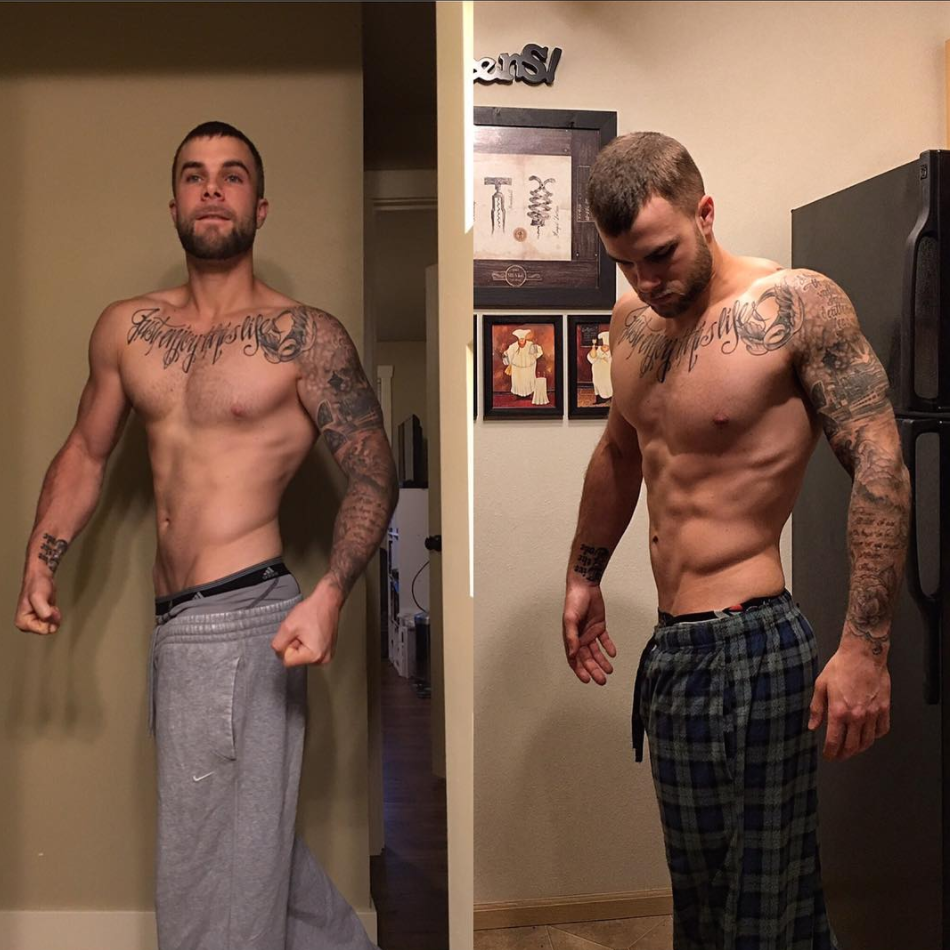Can you seriously lose 8-10lbs in 6-8 weeks, without destroying your hormones and binge eating the weight back on right after the diet is over?!
In the quickest answer possible, yes. You can do this and see serious fat loss cut results. But it’s not as simple as it may seem. Let’s back track a little bit and discuss what’s really going on here so I can teach you how to cut for fat loss.
What we’re going to discuss today, are “Mini Cuts”. This is becoming pretty popular amongst a lot of people as of late, especially guys in the bodybuilding community. Well, as you know, my craft in this industry is body composition transformations – with a lifestyle-based approach.
But as you can imagine, I study the hell out of natural bodybuilders and what they do. Because even if the majority of my clients are people who just want to lose their gut, love handles, and feel good being naked… nobody does better at building muscle and losing body fat, than bodybuilders (natural ones at that).
Add to that, I personally strive to be as lean as possible and have many guys who hire me for the exact same reason.
Anyway, I digress… back to you and losing 8+lbs in 6-8 week time span. I don’t know exactly what you’re thinking right now, but if you’re thinking like I was when I first read about “Mini Cuts” I was thinking “Crash Diet”.
By the way, I hate crash diets. They truly are disaster plans that don’t lead to any sustainable results, long-term habits, or any true success stories.
So what differs from crash diets and mini-cuts? Because they’re about the same time and to be fully transparent, mini-cuts are pretty aggressive as well and both have the simple goal of seeing fat loss cut results, FAST.

CRASH DIETS.
These are typically very restrictive approaches based off some false promising fad, such as: Gluten Free, Fats Are Bad, No Carb Diets, Cleanses, Supplement Based Diets, etc….
When we follow a crash diet that is based off of an opinion or current fad in the media, we then eliminate flexibility and any real choice of what we can eat, when we can eat, and how we’re supposed to eat. This means following a very rigid plan with minimal to zero adjustments or room for substitution.
Another reason crash diets are very promising, only in the short term, is because they do not have an after plan. Crash diets are meant to get you to your result as fast as possible, but not teach you how to come out of it. This is the exact reason you hear horror stories from people jumping on a diet, losing 30lbs in 30 days and then gaining 45lbs within the 3 months afterwards.
MINI-CUTS.
As mentioned before, mini-cuts were originally designed by natural bodybuilders to ensure not getting too fat in their off season. They knee that if they took a year to bulk, but implemented multiple 4-6 week aggressive mini-cuts – they’d essentially:
- Minimize fat gain in the off season
- Keep their confidence higher instead of hiding under baggy shirts every day
- Stay leaner, making it easier to gain muscle mass when they went back to the bulk (due to better insulin sensitivity and nutrient partitioning)
- Have less fat to cut when it came time to prep for contest again
- Be healthier (yeah, that’s important too…)
- Have the ability to visually see muscle definition, which not only feels good but also can help them determine what they need to work on.
“Ok… This sounds fantastic and all, but what about the rebound afterwards? Won’t they just binge and gain a bunch of weight afterwards too?”
No, because there is a plan. See with a mini-cut, we determine exactly how much weight we will lose and also how much we will likely gain right back due to water retention and calories being brought back up.
With a crash diet, most people plan to lose as much as possible and just hope it stays off.
With a mini-cut we assess your physique and determine, for example, that you should plan to lose 8lbs and gain 1-2lbs back right afterwards. So during this 4-6 week aggressive cut, you plan to KEEP OFF 6lbs of fat.
“Wait… 4-6 weeks? I thought this was a 6-8 week plan?!”
It is a 4-6 week “cut” but when I’m working with someone on this, we plan to work together on this for 6-8 weeks because you MUST know how to get back into your normal caloric intake and have some accountability to actually stick to the plan (so you don’t blow back up).
So by now, you should know that mini-cuts are not crash diets and that they’re by far more superior. If not and you’re still confused, feel free to email me at [email protected] and I can answer any of your questions on this (or regarding any form of cutting).
You should also know – if not, I’m telling you right not – that you don’t need to be a bulking bodybuilder to incorporate them.
But the truth is, they’re not for everyone… So lets run down the requirements needed before starting a mini-cut and how to go about them.
Mini-Cut Prerequisites

1.) Must Be Tracking Calories Already.
If you don’t know where you’re at, then we cannot determine how to get where you want to be. Mini-cuts are pretty specific and they are based off tracking calories and macros, which is another big thing that separates them from crash diets.
2.) Must Be Willing To Track Your Macros, Daily.
During a mini-cut, I’m not going to tell you to just cut out all dairy and gluten while taking this detox juice every night for 30 days… I’m going to give you metrics; these metrics are like your budget. This means if you have 1,750 calories and XYZ Protein/Fats/Carbs to work with, you better budget your food to fit within those metrics. It’s best to eat whole foods (fruits, veggies, lean meats, etc.) so you can fill those calories up with truly filling nutrients, but the choice is up to you.
3.) Must Commit To Weekly Accountability.
Even though most people need this regardless of the diet they’re on or result they’re searching for, this is a must with a mini-cut. This is simply because each week may change and each individual responds differently to a min-cut. Targeted rate of loss should be about 1% of bodyweight weekly, which usually lies between 1-2lbs weekly. But if you jump up to 3lb, you know you took your approach too aggressively and at this point we’re sacrificing muscle and performance, which is not an option here.
(The sure shot way to make sure you get serious results and actually sustain them, is having a coach during this process – click here to apply for your mini-cut today)
4.) Must Be Within 10-15% Body Fat, Ideally. (Males, Females between roughly 17-22%)
Truth is, this isn’t for the obese individual – because it’s designed for someone to go from a little fluffy to pretty damn lean in a short period of time, so they can move back onto gaining lean muscle mass again.
If you’re above 15% body fat as a male, you should likely be focused on a longer phased diet plan to get you into a lean and healthier range on a consistent and sustainable basis. Then later on down the road, you can consider a mini-cut.
You also shouldn’t be below 10% body fat, because at that point… You are lean enough and any leaner can compromise your hormones. If you’re at 9% and want to get on stage at 6%, once again that is a longer phased diet that you should hire a coach and plan accordingly for.
If you’re at 9% and want to be at 8%, I get it… You can use this approach but your plan should be to lose the minimal amount of body fat each week and likely no longer than 4 weeks.
5.) Must Have Some Grit.
You’re just truly going to need to be ready to grind out some rough training sessions while having low energy levels due to caloric restriction being in full effect. You’re also going to need to be ready to be hungry, because truth is… when you’re in a diet; you’re going to be hungry!
Just stay strong and remember this is temporary. Some things that may help would be: increasing water intake, lower meal frequency to 3 meals per day (making them larger meals), choose high fiber carb/veggie sources, eat lean proteins, and raise protein to about 1-1.2g per pound of bodyweight (maintain more muscle and stay satiated more easily).
6.) Must Have A Plan For After The Mini-Cut.
Without a plan afterwards, you will likely gain body fat back and more than likely it will be more than you’re satisfied with. Once again, the smartest thing to do in order to make sure you get serious results and keep those results – is to have a coach. Click Here to Apply for an Opportunity to Start Your Mini-Cut Today.
A couple things to consider for your post cut plan:
– Know Your Maintenance Calories.
If you do not know what your maintenance calorie intake was that you started with, you don’t know what to work back into.
– Take The Course of 1-2 Weeks To Adjust Back.
Over the course of 1-2 weeks, bring your calories back up to maintenance and STAY THERE for another 4-6 weeks before trying to “bulk” again. If you’re happy with where you ended up and plan to maintain that weight, stay there for 1-3 months. This allows the body to re-adjust and re-set its body fat levels to an extent – making it more likely to actually maintain the results you received.
– Raise Training Volume Slightly.
Going back into maintenance will be an increase in calories, about 30%, which means… More food! This also means more fuel and more calories to put to work, so up your training volume just slightly so those calories can go to work for you instead of against you.
– Continue Tracking Everything.
If you don’t continue to track calories and weight, there’s no telling if you’re maintaining the right caloric intake and if you’re maintaining the right body weight post cut (which will likely be within 1-3lbs of what you resulted in depending on your loss during the cut).
To conclude this article… we’ve learned:
Mini-Cuts are not crash diets; they’re more structured and provide a fast track to fat loss without the rebounding effects that crash diets tend to have.
Natural bodybuilders originally created them, the masters at getting lean and maintaining muscle mass – so we know they have some validity to them.
They’re not for everyone; in fact they’re for a pretty specific individual and anyone who has a decent amount of body fat to lose or needs a complete lifestyle change towards a leaner and more healthy life, should consider the long-term fat loss plan.
They work best with massive structure, guidance, expert advice on adjusting along the way, and serious accountability – Once again, Click Here Now to Apply for an Opportunity To Start Your Mini-Cut Today.





















































































































































































































































































































































































































































































